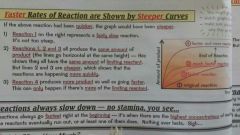![]()
![]()
![]()
Use LEFT and RIGHT arrow keys to navigate between flashcards;
Use UP and DOWN arrow keys to flip the card;
H to show hint;
A reads text to speech;
18 Cards in this Set
- Front
- Back
|
how can you tell when magnesium chloride and hydrochloric acid are reacting? |
it fizzes and bubbles of gas are given off |
|
|
what is meant by the limiting reactant in a chemical reaction and how did it affect the product? |
the limiting reactant is the reactant that runs out first in reaction, it's directly proportional to the amount of products made
this the because the more/less limiting reactant, the more/less limiting reactant particles to react with, and the more/less product particles |
|
|
describe the different reactions on the graph |

|
|
|
what is a reversible reaction? |
a products can react to convert back to the original chemicals.
a + b <=> c +d |
|
|
reversible reactions will reach equilibrium. what does this mean? what conditions are needed? |
-when the forward and backward reactions go at the same rate, so although reactions are still going on the concentrations won't change. -as the reactants a & b react their concentration falls so the forward reaction will slow, but as the products increase the backward reaction will speed up, creating more of a & b. this balances out to reach equilibrium - for this to occur the reaction has to be in a closed system |
|
|
the position of an equilibrium can lie to the right or left. what does this mean? |
equilibrium doesn't mean the amount of reactants and products are equal. sometimes it'll lie to the right (more products than reactants) or the left (more reactants than products)
it all depends on the conditions and the reaction taking place |
|
|
how come a catalyst won't change the position of an equilibrium? |
catalysts will speed up both the forward and backward reactions,so they'll make the reaction reach equilibrium quicker, but you'll end up with the same amounts of products/reactants |
|
|
how can temperature affect the equilibrium position? |
all reversible reactions are exothermic in one direction ms endothermic in another. equilibria always try to minimise any changed make to the conditions, so if u increase the heat it'll favour the endothermic reaction and vice versa |
|
|
how can pressure affect the equilibrium position? only with gases |
if you increase pressure the equilibrium with favour the reaction that creates fewer moles of gas (and vice versa) this is in an attempt to keep the conditions the same |
|
|
how can concentration affect the equilibrium position? |
if you increase the concentration of reactants the equilibrium shifts to the right to make more products
vise versa |
|
|
what is the contact process? |
3 stages..
reacting sulfur and oxygen to make sulfur dioxide by burning sulfur (equation)
sulfur dioxide reacts with oxygen to produce sulfur trioxide(catalyst present) sulfur trioxide reacts with water to produce sulfuric acid |
|
|
how are the conditions in stage 2 optimised? |
it's reversible so to get a higher yield conditions are controlled - temperature: 450°C despite the forward reaction being exothermic so that should be colder the rate of reaction would be too slow so a compromise is made - pressure: 1 atmosphere. there's height pressure in the reactants so it naturally to the right also increasing pressure is expensive so it's not worth it - catalyst (vanadium pentoxide) |
|
|
what do acids do in water? |
they ionise to produce H+ ions |
|
|
acids can be strong or weak. how do they differ interns of h+ ions? |
strong acids ionise completely in water weak acids don't fully ionise so there are some hydrogen ions but some are not. it's a reversible reaction where the equilibrium lies to the left |
|
|
how is the pH of acid measured? |
by looking at the concentration of h+ ions in solution can be measured using a pH meter and universal indicator |
|
|
what's the difference between acid strength and concentration? |
acid strength (strong or weak) is a measure of the degree of ionisation of the acid • acid concentration is a measure of the number of moles of acid in one d |
|
|
why are strong acids better electrical conductors? |
they have a higher concentration of ions so more charge can be carried though the solution |
|
|
explain why hydrochloric acid (strong) reacts fast than ethanoic acid (weak) of the same concentration. |
ethanoic acid has a lower concentration of hydrogen ions • in ethanoic acid the hydrogen ions have a lower collision frequency with reactant particles. |

